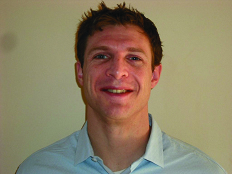By Bob Gorinski, DPT
One of my favorite pastimes as a boy was turning over rocks in the various creeks and woodland streams near my home in southwestern Pennsylvania. I was in search of salamanders, crayfish, frogs and any other treasures that inhabited those areas.
I realized that I was quite limited in the size and number of rocks that I could move. Even 15 minutes of this labor of love began to feel like backbreaking work. I was sure that larger prizes lay under the larger rocks, if only my 10-year-old frame could move them.
It is counterintuitive that a person can move something without using their arms. But one day, I realized that if I could straddle a larger rock and get a solid grip, I could then actually stiffen my arms and torso but otherwise not really use them. The arms and torso were simply a conduit from my lower body to my hands. This way, my legs could do the heavy moving.
I was amazed. I quickly discovered that my rock turning limits had immediately quadrupled, and I did not tire nearly as easily. My creature-finding abilities soared (well, in my mind). I had unintentionally discovered the benefits of what adult physical therapy and strength coaches today call functional training.
For athletes and adults of all ages, functional training involves building strength in a manner that optimizes efficient, graceful movement among all body segments. Gaining muscle size may or may not be a sought outcome, but a combination of strength and flexibility is always a goal. Functional training makes use of open space and basic free weights such as barbells, dumbbells and kettlebells. This is opposed to training methods that involve the trainee usually seated on and supported by various weight training machines working one or two muscles at a time. In functional training, the body is usually exercised as an integrated unit and there is no machine-guided path to balance and stabilize the resistance.
As a side note, cardiovascular-type training such as treadmills, stationary bikes and ellipticals provide many health benefits, but these do not substantially change the coordination of body segments — literally how you move — when your body is called upon to pick up a bag of mulch or reach high overhead to catch a ball or pick an apple from a tree.
Functional training is not new. It was first used by old-time weightlifters and strong men who were part of circuses or simply strength hobbyists. Most people didn’t identify with that image, and the fitness industry responded by creating gyms and gym culture filled with many of the technology dependent training that rose to popularity in the 1970s through 1990s. In recent years, many if not most gyms have incorporated a functional training section that includes free weights, various semi-firm boxes and other basic (but effective) equipment.
Functional training provides great benefit without being taken to extreme levels often seen on TV, with world-class athletes pushing themselves to their limits. Even athletes are beginning to learn that tearing the body down to an extreme state leaves little room for recovery and growth.
What is relatively new in functional training, however, is the known benefit of individual evaluation and exercise prescription. While functional training has the ability to spark great improvement in our ability to move well outside of the gym, without the fixed guidance and safety nets that exercise machines have to offer, there are certainly more risks involved for those who jump into the wrong exercises for their body type and abilities, or use unrealistic progression (too much too soon). Some individuals benefit from four to six weeks of simple posture and flexibility work before they are able to safely perform squats or hold a weight overhead.
Qualified personal trainers will be able to assist you with a training program that is appropriate for you. See a physical therapist to address any areas of pain you have been dealing with before beginning a functional training program.

Bob Gorinski, DPT
Full Reps Physical Therapy
Bob Gorinski, DPT, is a physical therapist and owner of Full Reps Physical Therapy in Camp Hill, PA. He specializes in orthopedic rehabilitation and has provided detailed personal training to athletes, young and old, to maximize their physical performance and prolong their years of high-level function. He loves helping others feel, look and perform their best! You can reach him by email at bobg@fullrepstraining.com and on the web at fullrepstraining.com.
Featured in Commercial Real Estate Review – First Quarter 2020

